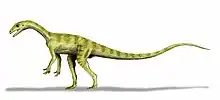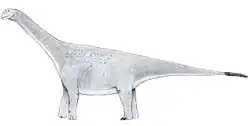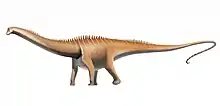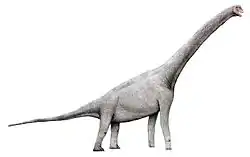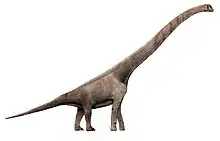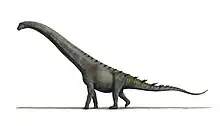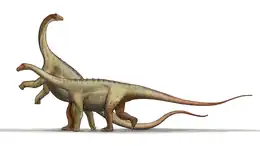| Kaijutitan | |
|---|---|
| Scientific classification | |
| Domain: | Eukaryota |
| Kingdom: | Animalia |
| Phylum: | Chordata |
| Clade: | Dinosauria |
| Clade: | Saurischia |
| Clade: | †Sauropodomorpha |
| Clade: | †Sauropoda |
| Clade: | †Macronaria |
| Clade: | †Titanosauria |
| Genus: | †Kaijutitan Filippi, Salgado & Garrido, 2019 |
| Type species | |
| †Kaijutitan maui Filippi, Salgado & Garrido, 2019 | |
Kaijutitan (meaning "Kaiju titan" after the type of Japanese movie monsters) is a genus of basal titanosaur dinosaur from the Sierra Barrosa Formation from Neuquén Province in Argentina. The type and only species is Kaijutitan maui.[1]
Discovery and naming
Kaijutitan was discovered by a team of researchers from the Museo Municipal Argentino Urquiza and the Museo Provincial de Ciencias Naturales “Prof. Dr. Juan Olsacher" from a layer from the Sierra Barrosa Formation, in Cañadón Mistringa, about 9 km southwest of the city of Rincón de los Sauces, in Neuquen, Argentina.
Description
Kaijutitan is known from the holotype MAU-Pv-CM-522, stored at the Museo Municipal Argentino Urquiza, Paleontología de Vertebrados, Cañadón Mistringa, which is a partial skeleton preserving elements from several parts of the skeleton.
It can be distinguished from other titanosaurians through the possession of unique traits: the width between the basal tuberosities is almost four times the width of the foramen magnum; the foramen for the internal carotid artery is located on the back of the basipterygoid, almost at the middle of the distance between the basipterygoid and the basal tuberosities; the anterior cervical vertebrae have bifid neural spines; a medial tuber located behind both metapophyses on both cervical vertebrae; a spinopostzygapophyseal lamina bifurcated in the spinal sector, generating elongated deep pneumatic cavities on anterior cervical vertebrae; a posteroventral keel on the anterior cervical vertebrae, generated from the convergence of two ridges that originate from the bottom edge of the parapophysis; an accessory lamina that runs from postzygadiapophyseal lamina up to the spinoprezygapophyseal lamina in cervical vertebra; absence of proximal pneumatopores in dorsal ribs; the prespinal lamina is triangular, which is a product of a dorsal expansion in anterior caudal vertebra; the absence of a ventromedial process in the bottom of the scapula; the tibial proximal condyle is narrow, with its long axis anteroposteriorly oriented; the tibial cnemial crest projects forward; and foramina at the base of the ascending process of the astragalus.[1]
Classification
To test the systematic position of Kaijutitan, a phylogenetic analysis was conducted to resolve its affinities. A simplified cladogram, showing the results of the analysis, is presented below.[1]
| Titanosauria |
| ||||||||||||||||||||||||
References
- 1 2 3 Filippi, Leonardo S.; Salgado, Leonardo; Garrido, Alberto C. (2019-08-01). "A new giant basal titanosaur sauropod in the Upper Cretaceous (Coniacian) of the Neuquén Basin, Argentina" (PDF). Cretaceous Research. 100: 61–81. doi:10.1016/j.cretres.2019.03.008. ISSN 0195-6671.
